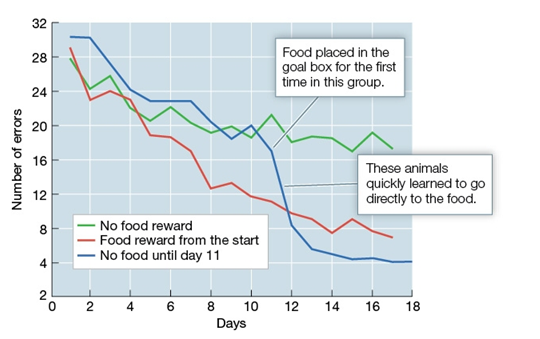Multiple Choice
Use the following to answer questions :
Refer to the graph below.

In an experiment, rats were placed in a complex maze with several one-way doors so that a rat wandering around would eventually reach the goal box. When a rat reached the goal box, it was returned to its home cage. This was repeated for several days.
Rats were assigned to one of three groups:
• Group 1 was provided food in the goal box every day.
• Group 2 was provided food in the goal box beginning on the 11th day.
• Group 3 was never provided food in the goal box.
Researchers measured how many errors the rats made across trials on the way to the goal box. Results are shown in the graph.
-According to the data in the graph,
A) rats that were never given food made the fewest number of errors as they navigated through the maze.
B) rats in all three groups learned to navigate through the maze at the same level of proficiency.
C) rats receiving food in the goal box from the beginning quickly learned to go there with few errors.
D) rats that were never given food eventually gave up trying to find their way through the maze.
Correct Answer:

Verified
Correct Answer:
Verified
Q7: Two groups of subjects are asked to
Q8: Andre was unable to make a paper
Q9: Social monitoring, or social _, occurs when
Q10: To stop coyotes from attacking and devouring
Q11: Behaviorists were especially critical of Edward Tolman's
Q13: Your sister watches a video about how
Q14: In an experiment, rats were given sweetened
Q15: A stimulus is<br>A) something that is relatively
Q16: Behaviorists were particularly skeptical of Edward Tolman's
Q17: Suppose you have a phobia of flying.